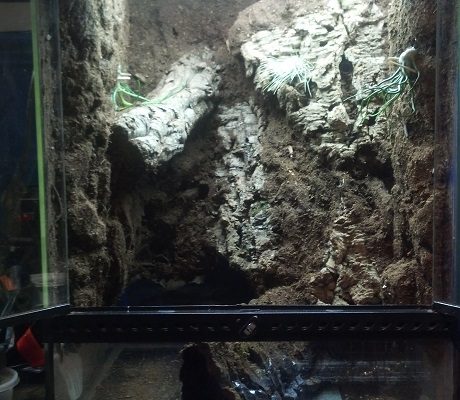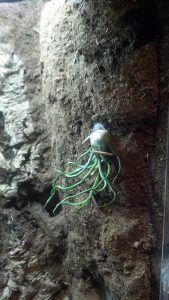

Now that the Great Stuff background is dried and cut – shown in the picture above – it’s time for the messiest and stinkiest part of the build, silicone and cocofiber/peat mix. I don’t have a picture of the actual process because once started it not only creates a ginormous mess but it also must be done swiftly or the fibers won’t stick.
For the organic material, a 60-80% peat – organic, with no fertilizers or additives in it, mixed with cocofiber gives the background a more natural look than cocofiber alone. It’s best to have more than enough mixed up because once this process starts it must continue! Or again, the fiber won’t stick right.
So, working one side at a time, using black silicone that does NOT have mold inhibitors in it (which are toxic to fish and reptiles) I worked in small segments from bottom to top to spread silicone over the foam and then took gobbing handfuls of the peat/coco mix and pressed it into the silicone. Once it dries for 1-2 hours, then the terrarium is flipped up and all the loose organic material is gently knocked off the wall. Then, it’s cleaned off the bottom and the process repeated for each side.
When it’s done it looks like this –

Oh yeah, and the shoreline is Great Stuff’s Pond foam. It’s used in water areas as that’s what it’s meant for and black looks better uncovered than the cream colored regular stuff. The organic mix only covers the very top of the shoreline.
The next phase is the beginning of the fun part! Prepping to plant!
The land segment needs a drainage layer so the soil doesn’t get soggy and rot plant roots. Almost any non-toxic material can be used, rocks, lava rocks, clay balls etc. Charcoal that’s normally used in fish tanks helps keep undesirable odors out. Over that, place a layer of screening (not metal screening though) to keep the soil out of the drainage layer. Then it is time for…soil!
All my tanks are bio tanks – basically mini eco systems within glass. Depending on what plants are going in the percentage varies but the ingredients are mostly the same – organic garden soil, peat moss, cocofiber, leaf mold and leaf litter, bits of sheet moss, tiny rocks, sand, tiny bits of aspen and/or hardwood bark, aquarium charcoal. This is placed on top of the screen. After the planting process, wet moss and then a layer of leaf litter is added on top of the soil. After all that is in, the clean up crew is added.

As you can see, a bare vivarium drives me wonky so there’s some plants in there to green it up until the final and most intriguing stage – planting!
The little squid like plant on the side is an airplant – Josh’s Frogs is the best place to get them. They’re easy to attach with silicone and toothpicks to support the weight until the silicone dries. They don’t like constant humidity, so keeping them near the slit in the door or up by the screen top keeps them happy even in tank that is else wise humid.

Coming soon – Tree Pool Vivarium Build for Dragons! Pt. 3